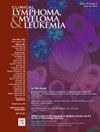需要透析的新诊断多发性骨髓瘤患者的预后。
IF 2.7
4区 医学
Q2 HEMATOLOGY
引用次数: 0
摘要
简介:肾损害(RI)是新诊断的多发性骨髓瘤(NDMM)的常见并发症,1-5%的严重RI患者需要透析,这与显著的发病率和早期死亡率相关。这些患者的治疗结果的真实数据有限。目的/方法:我们评估了73例连续需要透析的NDMM患者的肾脏反应模式和结果决定因素(2010年至2023年)。结果:中位年龄69岁;52%有高危细胞遗传学。所有患者均接受以硼替佐米为基础的诱导治疗(19%双胎,71%三胞胎,10%四胞胎;12%抗cd38抗体)。中位随访时间为37.2个月。31名患者(42.5%)在中位52天(范围3-247)后实现了独立透析。透析独立性与改善的生存(中位36个月对13.3个月,P = 0.085)和较低的早期死亡率(3.2%对14.3%,P = 0.15)相关。与独立透析相关的因素有:年龄较小(OR 0.92, P = 0.003)、高钙血症(OR 1.43, P = 0.013)和1个月时血液学反应(≥PR) (OR 3.7, P = 0.015)。在多因素分析中,年龄较小(P = 0.012, OR 0.93)和1个月时血液学反应(≥PR) (P = 0.014, OR 4.94)是透析独立性的独立预测因素。血液学反应深度(≥VGPR)显著影响肾脏恢复(OR 4.0, P = 0.020)。高危细胞遗传学独立预测不良预后(HR 3.67, P = 0.003)。结论:在以硼替佐米为基础的方案时代,42.5%的NDMM患者在没有特殊过滤器的情况下实现了透析独立,对预后有显著影响。对于诊断时依赖透析的患者,总体结果仍然很差,需要进一步评估抗cd38抗体的四联体方案。本文章由计算机程序翻译,如有差异,请以英文原文为准。
Outcomes of Newly Diagnosed Multiple Myeloma Patients Requiring Dialysis
Introduction
Renal impairment (RI) is a common complication in newly diagnosed multiple myeloma (NDMM), with 1-5% of patients presenting with severe RI requiring dialysis, which is associated with significant morbidity and early mortality. Limited real-world data exist on outcomes for these patients.
Aim/Methods
We assessed renal response patterns and outcome determinants in 73 consecutive NDMM patients requiring dialysis, treated in a single centre (2010 to 2023).
Results
Median age was 69 years; 52% had high-risk cytogenetics. All patients received bortezomib-based induction therapy (19% doublets, 71% triplets, 10% quadruplets; 12% anti-CD38 antibodies). Median follow-up was 37.2 months. Dialysis independence was achieved by 31 patients (42.5%) after a median of 52 days (range 3-247). Dialysis independence was associated with improved survival (median 36 vs. 13.3 months, P = .085) and lower early mortality (3.2% vs. 14.3%, P = .15). Factors associated with independence from dialysis were younger age) OR 0.92, P = .003), hypercalcemia (OR 1.43, P = .013) and hematologic response (≥ PR) at 1 month (OR 3.7, P = .015). In multivariate analysis, younger age (P = .012, OR 0.93) and hematologic response (≥ PR) at 1 month (P = .014, OR 4.94) were independent predictors of dialysis independence. Depth of hematologic response (≥ VGPR) significantly impacted renal recovery (OR 4.0, P = .020). High-risk cytogenetics independently predicted poor outcomes (HR 3.67, P = .003).
Conclusion
Dialysis independence is achievable in 42.5% of NDMM patients without special filters in the era of bortezomib-based regimens, with significant impact on outcome. Outcomes remain poor overall for patients who are dialysis-dependent at diagnosis and further evaluation of quadruplet regimens with anti-CD38 antibodies is needed.
求助全文
通过发布文献求助,成功后即可免费获取论文全文。
去求助
来源期刊

Clinical Lymphoma, Myeloma & Leukemia
ONCOLOGY-HEMATOLOGY
CiteScore
2.70
自引率
3.70%
发文量
1606
审稿时长
26 days
期刊介绍:
Clinical Lymphoma, Myeloma & Leukemia is a peer-reviewed monthly journal that publishes original articles describing various aspects of clinical and translational research of lymphoma, myeloma and leukemia. Clinical Lymphoma, Myeloma & Leukemia is devoted to articles on detection, diagnosis, prevention, and treatment of lymphoma, myeloma, leukemia and related disorders including macroglobulinemia, amyloidosis, and plasma-cell dyscrasias. The main emphasis is on recent scientific developments in all areas related to lymphoma, myeloma and leukemia. Specific areas of interest include clinical research and mechanistic approaches; drug sensitivity and resistance; gene and antisense therapy; pathology, markers, and prognostic indicators; chemoprevention strategies; multimodality therapy; and integration of various approaches.
 求助内容:
求助内容: 应助结果提醒方式:
应助结果提醒方式:


